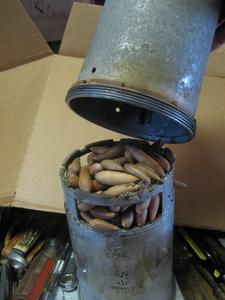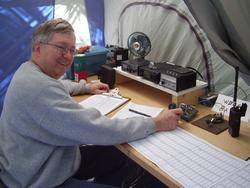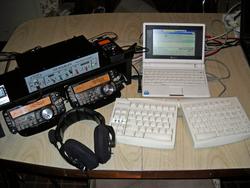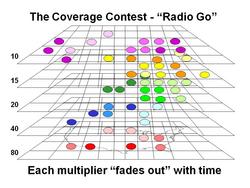 July 22, 2009 Editor: Ward Silver, NØAX | ||||||
IN THIS ISSUE
NEW HF OPERATORS - THINGS TO DO IOTA's islands and the Lighthouse-Lightship Week waft some cool marine breezes across the next couple of weekends. Summertime conditions may not be as spectacular as those of the fall contest season, but there is plenty to do and what could be more picturesque to imagine as you add to your logbook? BULLETINS If you have been having trouble submitting your CQWW VHF Contest log, please QRX while the calendar is updated to accept 2009 logs. Sorry for the inconvenience. 73! (Thanks, John W1XX, CQ WW VHF Contest Director) For the IOTA Contest coming up this weekend, the correct Web URL for information is http://www.vhfcc.org/hfcc/rules/2009/riota.shtml. The URL was changed recently. BUSTED QSOS Apologies for not having the right set of contests in the Upcoming Contests section last time. Hopefully, no one missed out on a favorite event! CONTEST SUMMARY Complete information for all contests follows the Conversation section July 25-26
Aug 1-2
NEWS, PRESS RELEASES, AND GENERAL INTEREST In parallel with the ARRL UHF Contest, 2009 marks the sixth year running that the Northern Lights Radio Society (NLRS) is regionally sponsoring Rovermania!. Rovermania! has the expressed purpose of generating activity and fun on the bands above 222 through roving. To foster UHF contest activity the NLRS has also sponsored a Limited Rover Award (not to be confused with the newer ARRL "Limited Rover" category) just for the ARRL UHF contest and Rovermania! (Thanks, Jon WØZQ)
Icom Japan is sponsoring the first ever worldwide D-Star Contest from July 25th to the 31st. Categories of entry include repeater and simplex, including multiple entries in different categories. Check out the Web site for information on prizes and more about operating in the contest. (Thanks, Ray N9JA) With hurricane season looming, we should all be aware of the major emergency net frequencies. These nets can be activated on short notice, and if in session, should be avoided during phone contests. From the July 15th edition of the ARRL's ARES E-Letter, here are links to the primary HF emcomm Web pages: WX4NHC at the National Hurricane Center, Hurricane Watch Net, SKYWARN, Salvation Army Team Emergency Radio Net (SATERN), The Waterway Net, and the VoIP SKYWARN/Hurricane Net. (The latter is an Internet-based operation, but of interest.) Uli KK8I/DL2HBX has been in the US for a while and is returning home to Germany. He contributed this nice note to the US contest community, "It has been a great ride and I would like to thank the US contest community for all the fun and camaraderie, both on and off the air. I am grateful for the hospitality of the contesters in the region, namely K8CC, K3LR, KT8X, W1SKU and K8AZ who invited me to operate individually or with a team from their fine stations which are way superior to my 100W / G5RV approach at home. Thanks as well to K8BB and K8CC for fun mobile operations and to the teams of W8TNO and K8EPV for great Field Day experiences...I am leaving the U.S. with fond memories, some 'wood' for the German shack wall and, most importantly, the many friendships that I have made here. Cuagn from DL! 73! The 2009 Austin Summerfest is August 7th and 8th, at the Austin Airport Marriot South Hotel. The DX and Contest Forum is being sponsored by the Central Texas DX and Contest Club, running from 10 AM to noon on Saturday. This year, there's no conflict with the NAQP CW! The CTDXCC's program will include a CW copying contest with a Begali paddle as first prize. (Thanks, Ken WM5R) Byelorussian hams now have full access to 7.100-7.200 MHz and 1.810 - 2.000 MHz. French hams anticipate access to 7.100 - 7.200 MHz "real soon now," as well. Watch for them in the upcoming contest season! Here's a Morse code tutorial by NØHR for the Pocket PC that will run on Windows Mobile. Just the ticket for code practice while out and about. K7QO's many MP3 files of Morse can also be played back on just about any mobile audio player, as well. Another source of MP3 CW files is this ebook-to-CW converter software and all W1AW code practice files are available online as MP3s. (Thanks, Paul AA9GG, Craig KJ4NJF, Majdi NØRMZ, and Tom WA8WPI)
After years of moderating the Topband reflector, Bill W4ZV, has handed the reins (reigns?) to Tree N6TR. The Top Band community extends its thanks to W4ZV for his leadership in making the Topband reflector a resource to all its subscribers. For detailed information on transient suppression, Jim W6RMK recommends "Protection of Electronic Circuits from Overvoltages" by Ronald Standler and published by Dover. The text covers the details of circuit design that are often overlooked. Control of rotators is taking on a new sophistication with this nice-looking application, PstRotor, by YO3DMU. It handles just about every controllable rotator in common use and includes automatic tracking for satellite communications. (Thanks, Al K3TKJ) What do you get when you combine Long-Delayed Echoes, moonbounce, and ARQ protocols? How about the Interplanetary Internet? Just such a network has been successfully tested by NASA for carrying data between Earth and interplanetary probes! The experiment is chronicled by Elise Ackerman in the July 2009 issue of the IEEE's Spectrum magazine. Web Site of the Week - Here's a neat way to place an remote antenna tuner right at the antenna and control it from inside the shack. Dan N3OX has used some light-duty hobby gear motors and a simple servo circuit to make it all work just like you expect. He's upgrading to stepper motors, but the story makes interesting reading - as do all of his project descriptions. WORD TO THE WISE Soapbox - a time-honored custom of adding comments and short stories to your contest log submission. There are two methods of submitting Soapbox for ARRL contests. The first works for any contest - use the SOAPBOX: tag of the Cabrillo header to add text. If you have photos to share, use the ARRL Soapbox upload page. It's a lot of fun and a great way to add to everyone's enjoyment of the contest - pick your contest and let 'er rip! SIGHTS AND SOUNDS The recent MakerFaire in San Mateo drew somewhere north of 80,000 participants, all eager to see hands-on, do-it-yourself activities. Yes, ham radio and the ARRL were there (see page 12 of the August 2009 QST). Bob NQ1R has posted a few videos on YouTube - take a look! (Thanks, Mike K6MFW) APRS demo part 1 featuring Leigh Klotz WA5ZNU APRS demo part 2 featuring Leigh Klotz WA5ZNU APRS demo part 3 featuring Chris Kantarjiev, K6DBG Project Building featuring Yuki Klotz-Burwell, K6YUU Amateur Television featuring Ben Carlucci W2NYC Emergency Communications featuring Philip Stripling KG6ILU While you're logged on to the IEEE site reading about the Interplanetary Internet, check out "The Art of Failure 2009" - a series of microphotographs from failed electronic devices. Very cool. RESULTS AND RECORDS The results for the 2009 ARRL DX CW Contest by Scott W4PA are now online. Certificates for the 2008 IARU HF World Championship have been mailed. IARU certificates for non-US/VE stations are first sent to the applicable IARU Member Society headquarters, where they are signed and then mailed to the individual station. (Thanks, ARRL Contest Branch Manager, Sean Kutzko KX9X)
Dink N7WA has begun a Soapbox page for the 2009 IARU HF contest - have at it! Let's hear your stories! The results of the 2008 Ohio QSO Party are now available on the new Ohio QSO Party Web site. We hope to see everyone in the 2009 Ohio QSO Party on August 22. (Thanks, Jim K8MR) The Oceania DX Contest Committee is pleased to advise that the results of the 2008 OCDX Contest have been published. Participation in the 2008 contest is the highest recorded to date with 783 logs submitted. This is most encouraging, considering that conditions on the higher bands were generally poor due to the lack of solar activity. (Thanks, Oceania DX Contest Committee; ZL1AZE, VK3TZ, ZL3GA, VK7GN, VK2FHN, VK6DXI, ZL2BSJ/PE7T) The results of the monthly Adventure Radio Society Spartan Sprint are now available. Despite difficult summer conditions, activity was good and scores were, too. Take a look and see who won the Tubby and Skinny categories! (Thanks, Richard KI6SN and Chris K6DBG) OPERATING TIP Summertime low-band DX is NOT an oxymoron! Remember that in the Southern Hemisphere, it's the dead of winter and their QRN levels are at their lowest levels of the year. Cowboy up, brave the static crashes, and you might find some juicy multipliers! TECHNICAL TOPICS AND INFORMATION When splicing coaxial cables, Chet N8RA credits AA7FV for the following technique of creating an electrically and mechanically sound joint. Start by trimming your coax pieces to expose at least ½-inch of center conductor while stripping and folding back the jacket and shield braid, but not removing them. This leaves enough braid to connect across the splice. Connect the center conductors by soldering a short length of brass hobby tubing over them. Next, use a piece of the coax dielectric material obtained during cable trimming to fill the gap - slit it lengthwise so that it will slip over the soldered center conductor. Make one wrap of electrical tape to hold the dielectric in place. Overlap and solder the shield braids from each piece of cable. Return the jackets and trim so that their ends meet without overlap. Double-wrap the whole joint with electrical tape. Finally, lay a long finishing nail across the joint and wrap again. The nail keeps the cable from being flexed or kinked at the relatively fragile splice. Pete N4ZR reports that Carl K9LA, Propagation Editor of the Contest Compendium wiki, has begun populating its Propagation section with lots of useful material. You might check out his Propagation Planning for DXpeditions and Propagation Planning for Contests pages. In addition, Ray ND8L found a great primer on propagation by Bob Brown, NM7M. It's called "Prop101" and can be downloaded from the the DXAtlas web site as a ZIP file.
Fans of wire antennas are likely to have the Extended Double-Zepp (EDZ) design in their toolboxes. Particularly good as a Field Day antenna, the double EDZ can develop as much gain as a small Yagi on its design band and gives good coverage on other bands. How about going one more step to the quadruple EDZ? Mike WA6ZTY reports "owning a frequency" during this year's Field Day with one of these 200-foot monsters. Everything you want to know about the EDZ family begins with the June 1938 QST article by W2DB - available in the online QST archives to ARRL members. That roll of wire in the garage is getting nervous! Using plastic enclosures outside requires UV-resistant material or the sun eventually causes them to crack and fail. Kirk K4RO report, "I've just re-built an omega matching network for tuning the boom of my top tribander on 40 meters. The network is mounted at the top of the mast, above the antenna, and it is quite difficult to mount and service. The first design used a plastic box from the kitchen, and the second, a child's thick plastic lunchbox that lasted almost ten years. I have finally learned the hard way that it pays to buy an outdoor UV-rated enclosure for such hard to reach projects. I like the boxes sold at electrical supply houses. These boxes are designed to be used outdoors. They are easy to drill, and some have sturdy mounting holes that can be adapted for tower mounting." Kirk has posted some images of the new UV-resistant tuning unit online to give you some ideas. Jim KK6MC reminds us that when using feed line that isn't 50-ohms, using integral multiples of half-wavelengths of the feed line will repeat the impedance from one end to the other. So if you connect 75-ohm hardline or coax to a 50-ohm load, a radio will see a 50-ohm match every half-wavelength along the line. This allows you to use the widely available and cheap low-loss RG-6 designed for TV and video use without creating an impedance mismatch. One caveat, this will only work on a single band or on bands that are harmonically related, such as 144 and 432 MHz or 14 and 28 MHz. Getting ready for a digital contest? Don AA5AU has developed a set of printable function key labels using a spreadsheet and they are available for downloading on his great RTTY Web site. Just print them and cut them out with scissors ("Don't run with those!" - Mom). They are easy to attach them to the keyboard. Digital TV may be less susceptible to the usual types of TVI, but as more people add antennas and preamps to receive the signals in fringe areas, overload from nearby ham transmitters may be a problem. Since most DTV signals are now in the high-VHF or UHF channels above 2 meters, a high-pass filter with a cutoff frequency below channel 7 (174 MHz) would work well. Microwave Filter Company series 3378 head-end filters are an example. They can be installed between an antenna and DTV receiver or preamp. Adding some common-mode ferrite chokes on the feed line can also reduce pickup of strong HF and VHF signals that could cause overload problems, as well. Even local paging and FM broadcast stations can cause overload problems - notch filters, such as those made by Winegard, help in these situations. (Thanks, Paul W9AC and Jim K9YC) If you have a four-square antenna, a resistive load is usually used to get rid of out-of-phase power. Dean N6BV suggests having the ability to route that power to a low dipole, instead. The low-power signal will make other stations aware of your presence on the frequency that might not hear your low-angle signal. And vice-versa - you will be aware of other local stations before firing up a CQ. Technical Web Site of the Week - Just how hot is that transistor? Save your fingertip and use a non-contact infra-red thermometer. Omega Instruments sells a number of such devices, starting in the $80 range and Harbor Freight is another excellent source. (Thanks, Bob WA2CKY and Bill W6WRT) CONVERSATION On Your Marks In considering the impact of technology and connectivity on radiosport, it's pretty obvious that while the effects of so much information can be to dull the radio "know how" required of contesters, there are also lots of opportunities for new types of contests that present plenty of challenges in their own way. For example, I recently learned of a hybrid geocaching-orienteering contest that combines radio, navigation, and physical fitness. The contest is run as a kind of road rally, with each team or individual starting in a staggered sequence. They are initially provided with a set of GPS coordinates for a geocache. Off they go in search of the cache. When they find the cache, what it contains is the frequency of the first hidden transmitter! The GPS receiver gets stashed and out comes the portable beam and handheld radio. Attached to the hidden transmitter are the coordinates for the next geocache, and so forth. The best time through the entire string wins. That sounds like a LOT of fun to me and it would be easy to extend to mobile operating over a wider area. Here's another idea - what if multipliers "evaporated" over the course of a contest? Instead of just allowing duplicate contacts, though, what if the idea was to sustain "coverage" of a multiplier? Like the board game Go, competitors "cover" a multiplier by working someone in that region. For example, let the grid fields (CN, EM, FN, and so forth) be the regions. By working someone in that grid field, the region is considered "covered" for some amount of time - maybe one hour. After that hour expires, you have to work someone else in that region to "re-cover" the multiplier.
Extended to multiple bands as in the figure, this could keep even a big station quite busy. Imagine a 160 through microwave "coverage contest" that measured one's ability to maintain communication over as wide a range as possible for as long as possible. That's similar to a DX contest, but with the added element that once worked, a multiplier needed to be "kept alive" by making more contacts. Imagine the strategic elements involved! Would it be better to CQ in order to attract callers from the regions? Or would Search-and-Pounce work out better? Likely, there would have to be a balance worked out between the rate at which needed multipliers call in and the need for new multipliers. It would certainly make Sunday more interesting in a DX contest! To make the decision, one would have to understand propagation, the capabilities of one's self and the station, gauge participation, have effective tools for measuring performance and guiding decisions, and so forth. Quite a challenge! You probably have your own ideas. I think we should have a weekend set aside as "Experimental Contest Day" to try out some of these great ideas! Initially, the contests could use paper logging and display tools, but if interest was strong enough, software would surely follow. It's a "simple matter of programming", right? (the most dangerous four words in the English language) If linked together, stations could actually play a game of Radio Go - surrounding or blocking or securing regions to accumulate points, only to have propagation continually rearrange the game board! What are your ideas for our Brave New Contesting World? Ready? Set? Go! CONTESTS 22 July to 4 August An expanded, downloadable version of QST's Contest Corral in PDF format is available. Check the sponsor's Web site for information on operating time restrictions and other instructions. HF CONTESTS IOTA Contest--Phone,CW, from Jul 25, 1200Z to Jul 26, 1200Z. Bands (MHz): 3.5-28. Exchange: RS(T), serial, IOTA number if island. Logs due: Aug 16. Rules Flight of the Bumblebees--CW, from Jul 26, 1700Z to Jul 26, 2100Z. Bands (MHz): 7-28. Exchange: RST, S/P/C, Bumblebee nr or power. Logs due: Aug 9. Rules TARA Grid Dip Contest--Digital, from Aug 1, 0000Z to Aug 1, 2359Z. Bands (MHz): 160-28, 50. Exchange: Name and grid square. Logs due: Sep 2. Rules Lighthouse-Lightship Week--Phone,CW,Digital, from Aug 1, 0001Z to Aug 9, 2359Z. Bands (MHz): 1.8-28, 50,144, Frequencies: See Web site. Exchange: Serial or ARLHS mbr/light nr, name, S/P/C. Logs due: Aug 31. Rules 10-10 Summer Phone QSO Party--Phone, from Aug 1, 0001Z to Aug 2, 2359Z. Bands (MHz): 28. Exchange: Call, name, 10-10 number, S/P/C. Logs due: Aug 17. Rules European HF Championship--Phone,CW, from Aug 1, 1200Z to Aug 1, 2359Z. Bands (MHz): 1.8-28. Exchange: RS(T), last two digits of 1st year licensed. Logs due: Aug 31. Rules North American QSO Party--CW, from Aug 1, 1800Z to Aug 2, 0600Z. Bands (MHz): 1.8-28. Exchange: Name and state. Logs due: 14 days. Rules South Africa DX Contest--Phone, from Aug 2, 1300Z to Aug 3, 1630Z. Bands (MHz): 3.5-14. Exchange: RS and serial. Logs due: 15 days. Rules VHF+ CONTESTS ARRL UHF Contest--Phone,CW,Digital, from Aug 1, 1800Z to Aug 2, 1800Z. Bands (MHz): 222+. Exchange: Grid square. Logs due: Sep 6. Rules 144 MHz Digital EME Championship--Digital, from Jul 25, 0000Z to Jul 26, 2400Z. Bands (MHz): 144. Exchange: TMO or RST and R. Logs due: Aug 9. Rules TARA Grid Dip Contest--Digital, from Aug 1, 0000Z to Aug 1, 2359Z. Bands (MHz): 160-28, 50. Exchange: Name and grid square. Logs due: Sep 2. Rules Lighthouse-Lightship Week--Phone,CW,Digital, from Aug 1, 0001Z to Aug 9, 2359Z. Bands (MHz): 1.8-28, 50,144, Frequencies: See Web site. Exchange: Serial or ARLHS mbr/light nr, name, S/P/C. Logs due: Aug 31. Rules LOG DUE DATES 22 July to 4 August July 22 - RSGB 80m Club Championship, SSB, email logs to: ccssb.logs@rsgbhfcc.org, upload log at: http://www.vhfcc.org/cgi-bin/hfenter.pl, paper logs and diskettes to: (none). Rules July 26 - Run for the Bacon QRP Contest, email logs to: (none), upload log at: http://www.fpqrp.com/autolog.php, paper logs and diskettes to: (none). Rules July 28 - ARCI Milliwatt Field Day, email logs to: contest@qrparci.org, paper logs and diskettes to: Milliwatt Field Day, c/o Jeff Hetherington, VA3JFF, 139 Elizabeth St. W., Welland, Ontario L3C 4M3, Canada. Rules July 28 - ARRL Field Day, post log summary at: http://www.b4h.net/cabforms/fielddayentry.php, paper logs and diskettes to: Field Day Entries, 225 Main St., Newington, CT 06111, USA. Rules July 28 - Marconi Memorial HF Contest, email logs to: contest.marconi@arifano.it, paper logs and diskettes to: ARI sez.di Fano, PO Box 35, 61032 FANO (PU), Italy. Rules July 28 - Ukrainian DX DIGI Contest, email logs to: urdigi@izmail-dx.com, paper logs and diskettes to: (none). Rules July 30 - Manchester Mineira All America CW Contest, email logs to: testcwjf@gmail.com, paper logs and diskettes to: CWJF Contest Committee, P.O. Box 410, Juiz de Fora - MG 36001-970, Brazil. Rules July 30 - GACW WWSA CW DX Contest, email logs to: auranito@speedy.com.ar or guillev@v2r.com.ar, paper logs and diskettes to: GACW DX Contest, PO Box 9, B1875ZAA Wilde, Buenos Aires, Argentina. Rules July 30 - RAC Canada Day Contest, email logs to: canadaday@rac.ca, paper logs and diskettes to: Radio Amateurs of Canada, 720 Belfast Road, Suite 217, Ottawa, Ontario K1G 0Z5, Canada. Rules July 31 - All Asian DX Contest, CW, email logs to: aacw@jarl.or.jp, paper logs and diskettes to: JARL, All Asian DX Contest, CW, 170-8073, Japan. Rules July 31 - SEANET Contest, email logs to: kops02@hanmail.net, paper logs and diskettes to: SEANET CONTEST 2009, c/o HL1IWD, Lee, Sung Ki, KDXC, CPO Box 162, Seoul 100-601, Korea. Rules July 31 - Original QRP Contest, email logs to: oqrpc@qrpcc.de, paper logs and diskettes to: Lutz Gutheil, DL1RNN, Bergstrasse 17, 38446 Wolfsburg, Germany. Rules July 31 - Digital Pentathlon, email logs to: dp2009@dqso.net, paper logs and diskettes to: (none). Rules August 1 - North American QSO Party, RTTY, email logs to: (see rules, web upload preferred), upload log at: http://www.ncjweb.com/naqplogsubmit.php, paper logs and diskettes to: Shelby Summerville, K4WW, 6506 Lantana Ct., Louisville, KY 40229-1544, USA. Rules August 1 - Feld Hell Sprint, email logs to: (none), post log summary at: http://www.emailmeform.com/fid.php?formid=202397, paper logs and diskettes to: (none). Rules August 1 - ANARTS WW RTTY Contest, email logs to: anarts@bartg.org.uk, paper logs and diskettes to: (none). Rules http://anarts.com.au/rules2009.htm August 1 - SMIRK Contest, email logs to: davidhcraig@verizon.net, paper logs and diskettes to: David Craig, N3DB, 4931 Mariners Drive, Shadyside, MD 20764, USA. Rules August 3 - MI QRP July 4th CW Sprint, email logs to: n8xx@arrl.org, paper logs and diskettes to: Hank Greeb, N8XX, 5727 11 Mile Rd NE, Rockford, MI 49341, USA. Rules August 4 - RSGB Low Power Field Day, email logs to: lowpower.logs@rsgbhfcc.org, paper logs and diskettes to: RSGB G3UFY, 77 Bensham Manor Road, Thornton Heath, Surrey CR7 7AF, England. Rules August 4 - DARC 10-Meter Digital Contest, email logs to: df5bx@darc.de, paper logs and diskettes to: Werner Ludwig, DF5BX, P.O. Box 1270, 49110 Georgsmarienhuette, Germany. Rules http://www.darc.de/referate/ukw-funksport/sonder/tei-digi.htm August 4 - PODXS 070 Club 40m Firecracker Sprint, email logs to: jbudzowski@verizon.net, paper logs and diskettes to: Jay Budzowski N3DQU, 109 S Northview Ave, New Castle, PA 16102, USA. Rules ACKNOWLEDGEMENTS ARRL Contest Update wishes to acknowledge information from WA7BNM's Contest Calendar and SM3CER's Contest Calendar.
| ||||||











